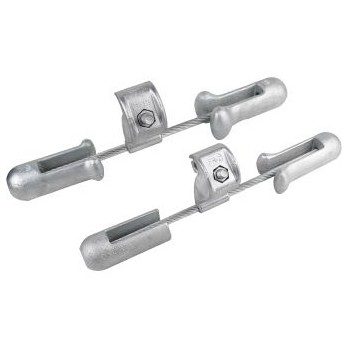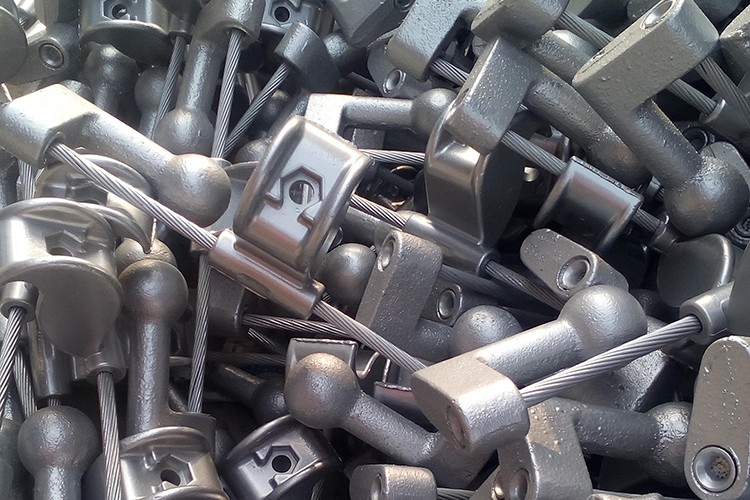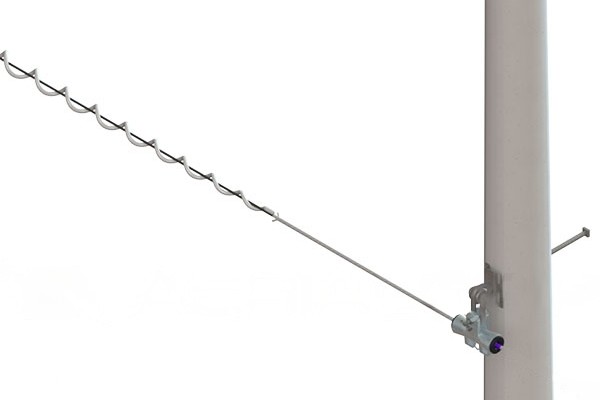Spiral vibration dampers are also known as helical or aeolian dampers used on power lines to mitigate the effects of wind-induced vibrations. These vibrations can lead to fatigue and stress on the conductors, towers and associated hardware. This may lead to damage or failure of the conductors. Spiral vibrations dampers are designed to dampen and control these vibrations to ensure the reliability and lifespan of power lines. Depending on conductor diameter, tension, and anticipated wind conditions, the dampers install at specific intervals along power lines. The dampers also reduce the risk of galloping or conductor slapping.
Types of vibration dampers
Spiral vibration damper is one kind of vibration damper. Different vibration dampers solve different conditions on the power lines and should hence be chosen carefully. The following are the common types of vibration dampers used on transmission lines.



- Stockbridge dampers
These are the most widely used helical vibration damper consisting of a central weight suspended by two or more steel messenger wires. The weight counterbalances while the brackets provide aerodynamic resistance to the wind-induced vibrations. They control various vibration frequencies and are suitable for various conductor sizes. - Twin-conductor dampers
These are designed for bundled conductors while multiple conductors are grouped together. They feature a central weight suspended by two messenger wires. The dual configuration allows for effective damping of vibrations in bundled conductors. - Spacer dampers
Spacer dampers control vibrations on spacer or spacer dampener systems used on high voltage systems. They are mounted directly onto the spacer units and feature a spiral bracket that generates an aerodynamic force. - Yoke-type dampers
These are designed for use on single conductors or smaller bundle configurations. They have a weight suspended from a yoke structure which is connected to the conductor by spiral brackets. They are lightweight and cost-effective, making them suitable for low to medium-voltage power lines. - Customized dampers
Customized spiral vibration dampers may be designed to meet specific project requirements. They are tailored to the unique characteristics of the power line. This includes the conductor size, span length, wind conditions and desired damping performance.
Applications of spiral vibration dampers


Spiral vibration dampers find applications in various industries and infrastructure projects beyond power lines. engineers can control and dampen vibrations induced by winds and enhance the reliability, safety and longevity of various structures and systems. Discussed below are the various applications of spiral vibration dampers.
- Fiber optic cables
Spiral vibration dampers work in fiber optic cable installations which prevent damage to the cables and ensure reliable communication. - Guyed masts and towers
These are used in telecommunications or broadcasting applications which experience vibrations caused by wind loads. - Overhead transmission and distribution lines
The spiral vibration dampers install on the conductors to control wind-induced vibrations, mitigate galloping, reduce conductor slapping and minimize the risk of fatigue failure. They enhance the reliability and longevity of power lines and ensure uninterrupted electricity transmission. - Suspension bridges
These are subjected to wind-induced vibrations that impact their structural integrity and stability. The dampers can work on the bridge cables to mitigate these vibrations and reduce the potential for resonance. - Industrial structures
Spiral vibration dampers work in industrial structures like cooling towers, chimneys or tall buildings. This ensures the stability and integrity of the buildings or industrial installations. - Cable-stayed bridges
These bridges utilize cables and pylons to support the bridge deck to mitigate these vibrations and enhance the safety and functionality of the bridge. - Wind turbine towers
Wind turbines are subject to dynamic loads induced by winds which lead to tower vibrations. The dampers reduce the vibrations and enhance the structural integrity and performance of the turbines.
Installation vibration dampers on power line projects

The installation process of the spiral vibration dampers depends on the damper type, manufacturer recommendations and project requirements. You should follow the manufacturer’s guidelines and consult with experienced professionals in the installation of spiral vibration dampers. This ensures the proper performance in controlling wind-induced vibrations on power lines. The following is a step-by-step process for installing the dampers.
- Engineering analysis is conducted before the installation to determine the optimal locations for their placement along the power line. This should consider factors like conductor type, size, span, length, wind conditions and the desired level of vibration damping.
- Damper selection is based on the engineering analysis to find the appropriate type, size and configuration of spiral vibration dampers are selected.
- The dampers are mounted directly onto the power line conductors. It involves securely attaching the dampers to the conductors using clamping mechanisms or other fastening methods.
- Spacing and number of dampers along the power line which is determined by the engineering analysis. This aims to distribute the dampers evenly along the power line to achieve effective vibration damping.
- After the dampers are installed, the tension of the power line conductors may need to be adjusted to ensure proper alignment and performance of the dampers.
- Once the installation is done, regular inspection and maintenance are essential to ensure their continued effectiveness.
Choosing the best product

There are various manufacturers of spiral vibration dampers in the market with different designs. This makes choosing the best dampers for you projects a bit tedious. The following are the key factors to consider when selecting the best dampers for your installation.
- Power line specification
Begin by assessing the specific characteristics of the power line including conductor size, tension levels, span length and anticipated wind conditions. - Vibration analysis
Conduct a thorough vibration analysis of the power line to identify the frequencies and amplitudes of the wind-induced vibrations. - Manufacturer’s record track
Choose vibration dampers from manufacturers with a reputation and a clean record in the market. This should also involve experience and expertise in power line projects. - Standards compliance
Ensure that the selected dampers comply with the relevant industry standards and specifications in your area. - Damping performance
Check the damping performance of the dampers by considering factors such as the effectiveness of vibration reduction, design and the chosen damping materials. - Durability and maintenance
Consider the durability and maintenance requirements of the dampers. You should look for dampers made from materials that withstand environmental conditions like UV exposure, temperature variations and corrosive elements. - Cost
Evaluate the cost-effectiveness of the dampers by comparing the costs of different damper options. Check on the performance, durability and long-term maintenance requirements. - Technical support
Ensure that the manufacturer offers adequate technical support like assistance with damper selection, engineering calculations, and installation guides among others.
FAQs
These are devices used to mitigate the effects of wind-induced vibrations on power lines. they enhance the reliability and lifespan of power lines.
Twin-conductor dampers
Yoke-type dampers
Stockbridge dampers
Spacer dampers
Customized dampers
Vibration reduction
Improved reliability
Cost-effective solution
Frequency limitations
Installation challenges
Maintenance
Wind load increase
Compatibility with other hardware
Initial cost


